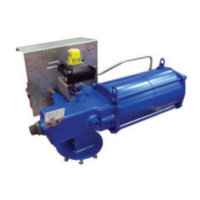15
5.3 Lubrication of mechanism
For normal duty the rack-and-pinion
mechanism of the actuator is lubricated
'forlife'.
In case of high load and high frequency of
operation it may be necessary to periodically
restore lubrication: it is advisable to apply a
generous coating of grease on the contact
surfaces of moving parts, especially on the
surface of the rack in contact with the thrust
bearing sliding block and on the teeth of the
rack and pinion.
For this operation proceed as follows:
1. Disassemble the actuator from the valve.
2. Measure the protrusion of the stop screw
(30) with reference to the end flange surface
(4), so as to be able to easily restore its
setting once the maintenance procedures
have been completed.
3. Loosen the lock nut and unscrew the stop
screw until it is removed.
4. Remove the nuts (25) from the tie rod (14) at
the end flange side: they must be gradually
unscrewed all at the same time so as to
release the thrust of the spring against the
flange.
5. Slide off the end flange (4) and the cylinder
tube (13).
6. Measure the protrusion of the thrust-
bearing screw (15), with reference to the
housing surface, so as to be able to restore
the right working position of the thrust
bearing sliding block with reference to the
rack once the maintenance procedures have
been completed.
7. Remove from the actuator the complete
spring module, the main components of
which are the piston (3), the spring (16), the
rack spacer rod (12), the spring retainer disk
(11) and the rack (5).
8. Remove the spacer tube (33).
9. Lubricate abundantly the teeth of the rack
and pinion and the surface of the rack in
contact with the thrust bearing sliding block.
Use recommended grease.
Prior to reassemble:
1. Check that the actuator components are in
good conditions and clean.
2. Substitute the gaskets and the O-rings if
worn or damaged.
3. Assemble all the components, taking care
not to damage the seals.
The following grease is used by Biffi for
standard working temperature and suggested
for re-lubrication (see table).
AGIP MU/EP/2 AEROSHELL GREASE 7 or equivalent
To be used in standard temperature conditions
(-30°C/+85°C)
NLGI consistency: 2
Worked penetration: 280 dmm
ASTM dropping point: 185°C
Base oil viscosity at 40°C: 160 mm²/s
ISO classification: L-X-BCHB 2
DIN 51 825: KP2K - 20
Equivalent to:
ESSO BEACON EP2
BP GREASE LTX2
SHELL ALVANIA GREASE R2
ARAL ARALUB HL2
CHEVRON DURALITH GREASE EP2
CHEVRON SPHEEROL AP2
TEXACO MULTIFAK EP2
MOBILPLEX 47
PETROMIN GREASE EP2
To be used in low temperature conditions
(-60°C/+65°C)
Color: Buff
Physical state: Semi-solid at ambient temperature
Odor: Slight
Density: 966 kg/m³ at 15°C
Flash point: >215°C (COC)(based on synthetic oil)
Dropping point: 260°C (ASTM D-566)
Product code: 001A0065
Infosafe no.: ACISO GB/eng/C
5.4 Dismantling and demolition
WARNING
Before starting the disassembly a large area
should be created around the actuator so to allow
any kind of movement without problems of further
risks created by work-site.
Before disassembling the actuator it is necessary
to close the pneumatic feed line and discharge
pressure from the cylinder of the actuator, from
the control unit and from the accumulator tank,
if present.
The opposition of pneumatic supply is
discharged from the cylinder by the linear
movement generated from the spring
releasing. It moves actuator and consequently
the valve, in hits fail safe position.
If actuator is still mounted onto the valve,
loosen the threaded connections between valve
and actuator (screws, tie rods, nuts)
Lift the actuator using the proper lifting points
(see sect. 2.2).
If the actuator needs storage, before
demolition, see chapter 2.3
WARNING
The demolition of the actuator both concerning
any electrical and mechanical parts should be
made by specialized staff.
Separate the parts composing the actuator
according to their nature (ex. metallic, and
plastic materials, fluids etc.) and send them
to differentiated waste collection sites, as
provided for by the laws and provisions in force.
RPS SPRING RETURN PNEUMATIC ACTUATOR
INSTALLATION, OPERATION AND MAINTENANCE MANUAL

